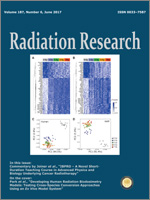Ionizing radiation can induce mutations, and the majority of radiation-induced mutations in mammalian cells are deletions. The most critical types of radiation-induced DNA damage are DNA double-strand breaks, and these breaks are repaired by either the homologous recombination (HR) pathway or the non-homologous end joining (NHEJ) pathway. The HR pathway is not as mutagenic as the NHEJ pathway, and it is expected that radiation-induced deletions would usually have little sequence similarity around the deletion junction points. Here we report sequence data from the regions around the rejoined junctions of 33 de novo copy-number mutations (27 deletions and 6 duplications) obtained from offspring sired by male mice that were irradiated at the spermatogonia stage and from nonirradiated controls. The results indicate that deletions can be classified into three major groups. In group 1, nine deletions were found to share long blocks of similar sequences (200–6,000 bp) at the junctions and the deletion size varied extensively (1 kb to 2 Mb) (e.g., illegitimate recombination). In group 2, five deletions shared short identical sequences (0–7 bp) at the junctions, and the deletion sizes were shorter than 200 kb (e.g., micro-homology-mediated repair). Additional three-deletion candidates of this group were also found but turned out to be inherited from mosaic parents. They are therefore not included in germline mutations. In group 3, twelve deletions shared little sequence similarity (only 0–2 bp) at the junctions (likely due to NHEJ repair) and deletion sizes were longer than 200 kb. Group 1 consisted of deletions found in both spontaneous and irradiated genomes and thus, were probably caused by spontaneous events during meiosis or DNA replication. Group 2 consisted mainly of deletions found in nonexposed genomes. Group 3 consisted primarily of deletions that occurred in the irradiated genomes. Among the duplications, we found no indication of any association with radiation exposures. These results indicate that large size (>200 kb) and little sequence similarity around the rejoined sites are likely to be a hallmark of radiation-induced deletions in mice.
How to translate text using browser tools
18 April 2017
Radiation-Induced Deletions in Mouse Spermatogonia are Usually Large (over 200 kb) and Contain Little Sequence Similarity at the Junctions
Mieko Kodaira,
Jun-ichi Asakawa,
Nori Nakamura





